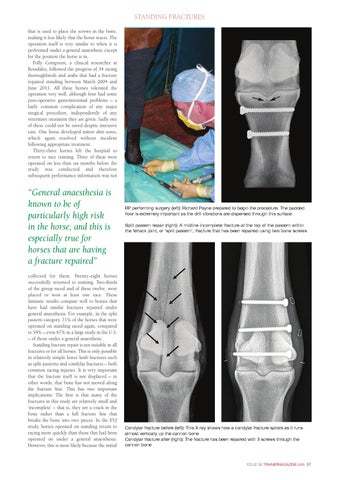STANDING FRACTURES ISSUE 39_Jerkins feature.qxd 20/08/2012 09:22 Page 2
STANDING FRACTURES that is used to place the screws in the bone, making it less likely that the horse reacts. The operation itself is very similar to when it is performed under a general anaesthetic except for the position the horse is in. Polly Compston, a clinical researcher at Rossdales, followed the progress of 34 racing thoroughbreds and arabs that had a fracture repaired standing between March 2004 and June 2011. All these horses tolerated the operation very well, although four had some post-operative gastrointestinal problems – a fairly common complication of any major surgical procedure, independently of any veterinary treatment they are given. Sadly one of these could not be saved despite intensive care. One horse developed minor skin sores, which again resolved without incident following appropriate treatment. Thirty-three horses left the hospital to return to race training. Three of these were operated on less than six months before the study was conducted and therefore subsequent performance information was not
“General anaesthesia is known to be of particularly high risk in the horse, and this is especially true for horses that are having a fracture repaired” collected for them. Twenty-eight horses successfully returned to training. Two-thirds of the group raced and of these twelve, were placed or won at least one race. These fantastic results compare well to horses that have had similar fractures repaired under general anaesthesia. For example, in the split pastern category, 71% of the horses that were operated on standing raced again, compared to 59% – even 67% in a large study in the U.S. – of those under a general anaesthetic. Standing fracture repair is not suitable in all fractures or for all horses. This is only possible in relatively simple lower limb fractures such as split pasterns and condylar fractures – both common racing injuries. It is very important that the fracture itself is not displaced – in other words, that bone has not moved along the fracture line. This has two important implications: The first is that many of the fractures in this study are relatively small and ‘incomplete’ – that is, they are a crack in the bone rather than a full fracture line that breaks the bone into two pieces. In the EVJ study, horses operated on standing return to racing more quickly than those that had been operated on under a general anaesthesia. However, this is most likely because the initial
RP performing surgery (left): Richard Payne prepared to begin the procedure. The padded floor is extremely important as the drill vibrations are dispersed through this surface Split pastern repair (right): A midline incomplete fracture at the top of the pastern within the fetlock joint, or ‘split pastern’, fracture that has been repaired using two bone screws
Condylar fracture before (left): This X-ray shows how a condylar fracture spirals as it runs almost vertically up the cannon bone Condylar fracture after (right): The fracture has been repaired with 3 screws through the cannon bone
ISSUE 39 TRAINERMAGAZINE.com 57
